|
The Civil War Battle of Goldsboro Bridge
Battle of Goldsboro Bridge, North Carolina
Battle of Goldsboro Bridge
North Carolina and the Civil War
| Battle of Goldsboro |

|
| Battle of Goldsboro |
| General John G. Foster |
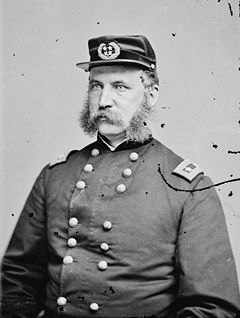
|
| (May 27, 1823 - September 2, 1874) |
Introduction
Goldsboro was a major rail line for the Confederacy. The goal
of the Goldsboro Expedition, aka Foster's Raid, was to capture the rails in concert with Burnside's attack
on General Lee at Fredericksburg in 1862. The Atlantic and North Carolina railroad intersected
at Goldsboro with the Wilmington and Weldon railroad (the lifeline of General Lee's Army of Northern Virginia). Foster attacked
Goldsboro in December 1862, burned the railroad bridge, but did not actually take the town. Upon burning the bridge, Foster
and his troops left for New Bern. The railroad was halted, but only briefly. Enough of the bridge was left intact to repair.
The Confederate forces were commanded by Brig. Gen. Thomas Clingman,
a former U.S. Senator from North Carolina. Clingman was an ardent lawyer, Fire-Eater, and
one of the most outspoken politicians of his era. His proslavery stance and position
on states' rights were summarized with his famous quote to Congress: "Do us justice and we stand with you; attempt to
trample on us and we separate!" He initially commanded the 25th North Carolina Infantry, which was popularized with the movie Cold Mountain starring
Jude Law as Private W. P. Inman (he really did exist). The former U.S. senator
would command Clingman's Brigade at the Battle of Goldsboro Bridge, and later, at General Lee's request, he
would advance his battle-hardened brigade into the thick of the fight at bloody
Cold Harbor and engage in fierce close range combat before routing the Union forces.
Brig. Gen. John G. Foster, commanding Union forces, was a West Point graduate who had recently proven himself as
a very capable brigade commander during the Burnside Expedition.
| Goldsboro, North Carolina: A Major Rail Center |
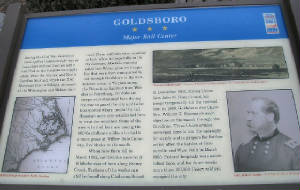
|
| Goldsboro in the Civil War |
The Battle of Goldsborough Bridge (present-day Goldsboro) was
fought December 17, 1862, at the Wilmington & Weldon Railroad Bridge across the Neuse River, three miles south of Goldsborough, North Carolina. Troops and supplies
aboard trains from the Deep South and the port at Wilmington had to cross this bridge on their way to Virginia, making this
bridge a vital link in the Confederate supply chain. Because of the intersection of two railroads at Goldsborough, the Wilmington
& Weldon and the Atlantic & North Carolina, that city had become one of the most important railroad centers in the
South. There were other railroad bridges and depots between Wilmington and Virginia, but the presence of the two railroads
at Goldsborough, with the fact that Goldsborough was only 60 miles from Union-occupied New Berne (period spelling), made the railroad bridge at Goldsborough an important objective for the Union War Department.
(Right) Battle of Goldsboro interpretive marker.
The War Department believed that the destruction of this bridge
would impact the ability of the Confederacy to wage war, if completed in conjunction with a major Union victory in Virginia.
A defeated Confederate army, denied re-supply, could be swept aside, leaving the Confederate capital at Richmond vulnerable.
The time to implement this plan arrived late in 1862. In December, the commander of the Union Army of the Potomac, General
Ambrose Burnside, was planning an attack on General Robert E. Lee's Army of Northern Virginia at Fredericksburg, Virginia. Plans were developed for the Union commander in North Carolina, General
John G. Foster, to simultaneously launch an attack from New Berne against the railroad bridge at Goldsborough. This expedition
has come to be known as Foster’s Raid.
| Location of the Battle of Goldsboro Bridge |
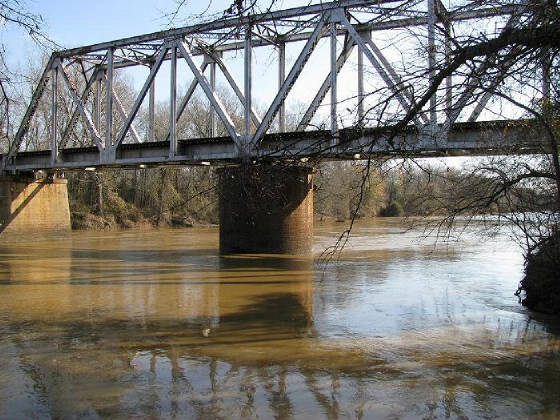
|
| Civil War Battle of Goldsboro Bridge |
Foster’s Raid
On the morning of December 11, 1862, General Foster marched from New
Berne with a force of 10,000 infantry, 640 cavalry and 40 guns. After meeting and defeating small Confederate forces at Southwest
Creek, Kinston and White Hall, Foster’s army arrived at the railroad bridge south of Goldsborough on the morning of December 17. Foster deployed
his troops and artillery and they began to fight their way to the bridge. The bridge was defended by Confederate General Thomas Clingman, who commanded a small force of less than 2,000 men and a dozen guns. The Confederates fought valiantly but were repulsed
east of the railroad and to the north bank of the Neuse River. After a two hour battle, a daring assault party of Union volunteers,
supported by artillery fire, rushed forward amidst a hail of bullets and set fire to the bridge. Union artillery subsequently
fired on the burning bridge, to aid in its destruction and to foil Confederate attempts to douse the flames. In a short while
the bridge was destroyed, and then Union troops further damaged the railroad by destroying the tracks for a distance of two
to three miles south from the bridge.
Confederate Counterattack
Late in the afternoon the Union troops, their objective met,
formed and began the long march towards their base at New Berne, leaving one brigade of infantry and one battery of artillery
as a rear guard to cover their withdrawal. On the north bank of the river, Confederate forces had been reinforced and for
the first time actually outnumbered the Union force that remained on the field. At a council of war, Confederate General Nathan
Evans, who had now arrived with a portion of his command, ordered Clingman to cross to the south bank of the river via the
county wagon bridge, located one half mile upriver from the burned railroad bridge, and attack the Union rear guard. Pursuant
to this order, Clingman led his brigade, Clingman's Brigade, which consisted of four North Carolina infantry regiments, the 8th, 31st, 52nd and 61st, across the bridge, supported
by other troops from North Carolina, South Carolina and Mississippi. Clingman posted the 31st and 52nd North Carolina Regiments
near the river bank and hurried one mile to the south with the 8th and 61st. At this point, Evans arrived on the south bank
of the river and ordered the 31st and 52nd to attack across the railroad and engage the Union rear guard. These two regiments
formed-up and crossed a cultivated field west of the railroad, then climbed the high railroad embankment. After pausing briefly
at the top, they streamed down the eastern face of the embankment shouting the rebel yell; appearing to one startled
Union soldier like “immense gray ants”. The sound of the Confederate attack attracted the attention of Union troops
that had just left the field and before the North Carolinians could reach the Union position, additional Union troops and
guns had rushed back onto the field. In a short time the Union force had grown into two infantry brigades and three batteries
of artillery and the odds were suddenly against the Confederate attackers. When within 100 yards of the Union line the Confederates
were met with musketry and double loads of canister fire from up to eighteen Union guns, and the Confederates were turned
back with heavy losses. Clingman’s other two regiments, the 8th and 61st North Carolina, were now in position but wisely
did not cross the railroad, and instead engaged Union forces from behind the embankment.
| Goldsboro, North Carolina, Map |
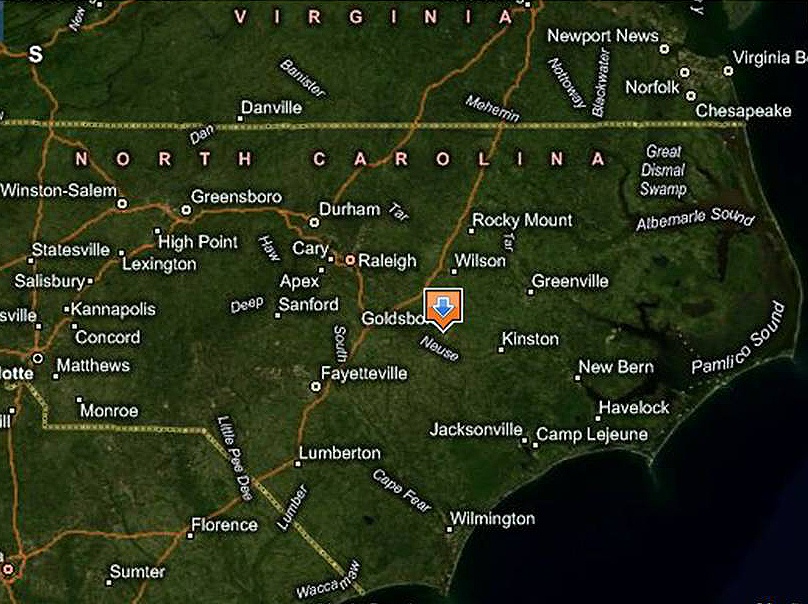
|
| Satellite Photograph Courtesy Microsoft Virtual Earth (3D) |
| Civil War Battle of Goldsboro |
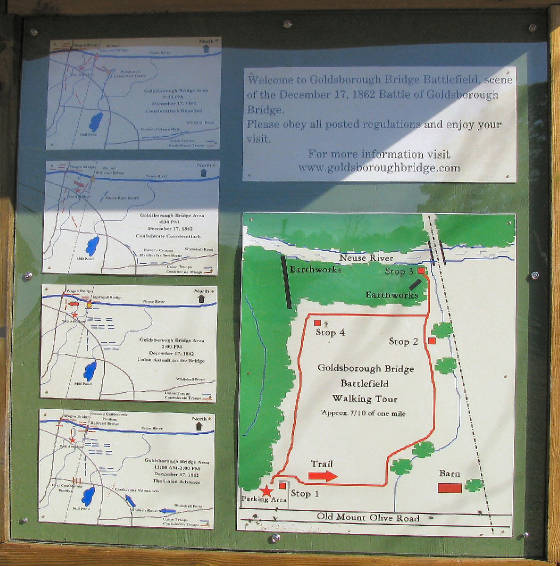
|
| Battle of Goldsboro |
| Route to Goldsboro |
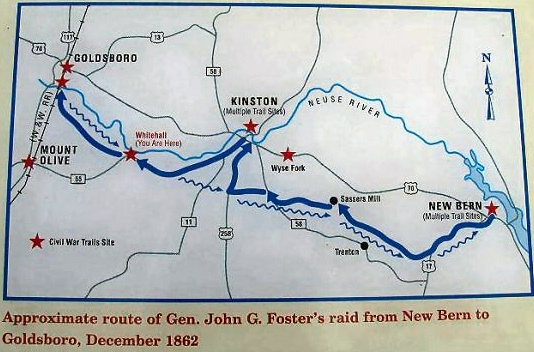
|
| Foster's Civil War Raid on the North Carolina Coast |
It was now quite late and as darkness descended on the battlefield
the firing died down. The Battle of Goldsborough Bridge concluded with nearly 250 men killed, wounded and missing. Foster’s
army once more turned to leave the field but was slowed by having to cross the freezing waters of a swollen stream--which
flowed behind the Union positions. During their counterattack, Confederate soldiers had destroyed the dam on a millpond through
which the stream flowed in an effort to trap the Union rear guard. Now Union soldiers were compelled to cross the rapidly
rushing stream, which was up to their necks. After crossing the stream, the soaked soldiers set fire to the woods on both
sides of their line of march, to warm themselves and light their way in the darkness. The Union army returned to
New Bern just before Christmas 1862. They left in their wake a torn and broken landscape, and 1,300 combined Union and Confederate
casualties.
Results
Foster’s Raid was a tactical success for the Union. The vital railroad
bridge near Goldsborough was destroyed, temporarily halting the flow of supplies from the Deep South and the port at Wilmington
to Virginia. The success Foster enjoyed at Goldsborough was muted, however, by events in Virginia. Burnside’s attack
against Lee at Fredericksburg was a disaster for the Union (which was soundly defeated). The triumphant Confederate army
in Virginia was thus able to withstand a temporary loss of supplies and reinforcements from the South, nullifying what would
have otherwise been a major strategic victory for the Union. Because of the importance of the Goldsborough Bridge to the Confederate
chain of supply, men and engineers were rushed to the site and the bridge was rebuilt in a matter of weeks. The next time
the Union army would get so close to Goldsborough was on March 21, 1865, when three Union armies over 100,000 strong, captured
the city and its vital railroad bridge and depots. These Union armies, commanded by Generals William T. Sherman, Alfred Terry
and John Schofield, used the railroad lines at Goldsborough to re-supply for a final push on the state capital at Raleigh,
which was to be followed by a link-up with General U. S. Grant’s army in Virginia. The three armies left Goldsborough
on April 10, 1865; just one day after General Robert E. Lee surrendered to Grant at Appomattox Court House, Virginia. The war was all but over.
Sources: National Park Service; goldsboroughbridge.com; Official Records of the Union and Confederate
Armies; North Carolina Office of Archives and History; Library of Congress; National Archives.
Recommended Reading:
The Civil War in Coastal North Carolina (175 pages) (North Carolina Division
of Archives and History). Description: From the drama
of blockade-running to graphic descriptions of battles on the state's islands and sounds, this book portrays the explosive
events that took place in North Carolina's coastal region during the Civil War. Topics discussed include the strategic
importance of coastal North Carolina, Federal occupation
of coastal areas, blockade-running, and the impact of war on civilians along the Tar Heel coast.
Recommended Reading: Storm over Carolina: The Confederate
Navy's Struggle for Eastern North Carolina. Description: The struggle for control of the eastern waters of North Carolina during the War Between the States was a bitter, painful,
and sometimes humiliating one for the Confederate navy. No better example exists of the classic adage, "Too little, too late." Burdened
by the lack of adequate warships, construction facilities, and even ammunition, the South's naval arm fought bravely and even
recklessly to stem the tide of the Federal invasion of North Carolina from the raging Atlantic. Storm Over Carolina is the account of the
Southern navy's struggle in North Carolina waters and it
is a saga of crushing defeats interspersed with moments of brilliant and even spectacular victories. It is also the story
of dogged Southern determination and incredible perseverance in the face of overwhelming odds. Continued below...
For
most of the Civil War, the navigable portions of the Roanoke, Tar, Neuse, Chowan, and Pasquotank rivers were
occupied by Federal forces. The Albemarle and Pamlico sounds, as well as most of the coastal towns and counties, were also
under Union control. With the building of the river ironclads, the Confederate navy at last could strike a telling blow against
the invaders, but they were slowly overtaken by events elsewhere. With the war grinding to a close, the last Confederate vessel
in North Carolina waters was destroyed. William T. Sherman
was approaching from the south, Wilmington was lost, and the
Confederacy reeled as if from a mortal blow. For the Confederate navy, and even more so for the besieged citizens of eastern
North Carolina, these were stormy days indeed. Storm Over Carolina describes their story, their struggle, their history.
Recommended Reading:
The Civil War in the Carolinas (Hardcover).
Description: Dan Morrill relates the experience of
two quite different states bound together in the defense of the Confederacy, using letters, diaries, memoirs, and reports.
He shows how the innovative operations of the Union army and navy along the coast
and in the bays and rivers of the Carolinas affected the general course of the war as well
as the daily lives of all Carolinians. He demonstrates the "total war" for North
Carolina's vital coastal railroads and ports. In the latter part of the war,
he describes how Sherman's operation cut out the heart of
the last stronghold of the South. Continued below...
The author offers
fascinating sketches of major and minor personalities, including the new president and state governors, Generals Lee, Beauregard,
Pickett, Sherman, D.H. Hill, and Joseph E. Johnston. Rebels and abolitionists, pacifists and unionists, slaves and freed men
and women, all influential, all placed in their context with clear-eyed precision. If he were wielding a needle instead of
a pen, his tapestry would offer us a complete picture of a people at war. Midwest Book Review: The Civil War in the Carolinas by
civil war expert and historian Dan Morrill (History Department, University of North Carolina at Charlotte, and Director of
the Charlotte-Mecklenburg Historical Society) is a dramatically presented and extensively researched survey and analysis of
the impact the American Civil War had upon the states of North Carolina and South Carolina, and the people who called these
states their home. A meticulous, scholarly, and thoroughly engaging examination of the details of history and the sweeping
change that the war wrought for everyone, The Civil War In The Carolinas is a welcome and informative addition to American
Civil War Studies reference collections.
Recommended Reading: Ironclads and Columbiads: The Coast (The Civil War in North Carolina)
(456 pages). Description: Ironclads and Columbiads
covers some of the most important battles and campaigns in the state. In January 1862, Union forces began in earnest to occupy
crucial points on the North Carolina coast. Within six months,
Union army and naval forces effectively controlled coastal North Carolina from the Virginia line south to present-day Morehead
City. Union setbacks in Virginia, however, led to the withdrawal of many
federal soldiers from North Carolina, leaving only enough Union troops to hold a few coastal strongholds—the vital ports
and railroad junctions. The South during the Civil War, moreover, hotly contested the North’s ability to maintain its
grip on these key coastal strongholds.
Recommended Reading: The Civil War in North Carolina.
Description: Numerous battles and skirmishes were fought in North Carolina during the Civil War, and the campaigns and battles themselves were crucial
in the grand strategy of the conflict and involved some of the most famous generals of the war. John Barrett presents the
complete story of military engagements across the state, including the classical pitched battle of Bentonville--involving
Generals Joe Johnston and William Sherman--the siege of Fort
Fisher, the amphibious campaigns on the coast, and cavalry sweeps such
as General George Stoneman's Raid.
Recommended Reading: Confederate Military History Of North Carolina: North Carolina
In The Civil War, 1861-1865. Description: The author, Prof. D. H. Hill, Jr., was the son of Lieutenant General Daniel
Harvey Hill (North Carolina produced only two lieutenant generals and it was the second highest rank in the army) and
his mother was the sister to General “Stonewall” Jackson’s wife. In Confederate
Military History Of North Carolina, Hill discusses North Carolina’s massive task of preparing and mobilizing
for the conflict; the many regiments and battalions recruited from the Old North State; as well as the state's numerous
contributions during the war. Continued below...
During Hill's
Tar
Heel State study, the reader begins with
interesting and thought-provoking statistical data regarding the 125,000 "Old
North State" soldiers that fought
during the course of the war and the 40,000 that perished. Hill advances with the Tar Heels to the first battle at Bethel, through numerous bloody campaigns and battles--including North Carolina’s
contributions at the "High Watermark" at Gettysburg--and concludes with Lee's surrender at
Appomattox.
Recommended
Viewing: The Civil War - A Film
by Ken Burns. Review: The Civil War -
A Film by Ken Burns is the most successful public-television miniseries in American history. The 11-hour Civil War
didn't just captivate a nation, reteaching to us our history in narrative terms; it actually also invented a new film language
taken from its creator. When people describe documentaries using the "Ken Burns approach," its style is understood: voice-over
narrators reading letters and documents dramatically and stating the writer's name at their conclusion, fresh live footage
of places juxtaposed with still images (photographs, paintings, maps, prints), anecdotal interviews, and romantic musical
scores taken from the era he depicts. Continued below...
The Civil War uses all of these devices to evoke atmosphere and resurrect an event that many knew
only from stale history books. While Burns is a historian, a researcher, and a documentarian, he's above all a gifted storyteller,
and it's his narrative powers that give this chronicle its beauty, overwhelming emotion, and devastating horror. Using the
words of old letters, eloquently read by a variety of celebrities, the stories of historians like Shelby Foote and rare, stained
photos, Burns allows us not only to relearn and finally understand our history, but also to feel and experience it. "Hailed
as a film masterpiece and landmark in historical storytelling." "[S]hould be a requirement for every
student."
|

